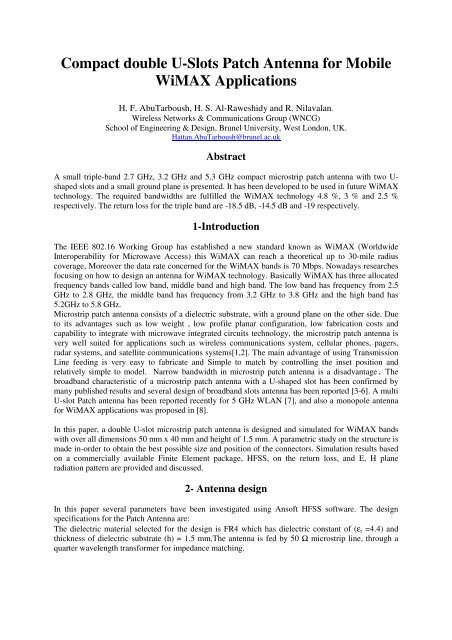Uslot Technologies
Welcome to USC Technologies USC Technologies has developed and made commercially available a breakthrough family of economical, electrolytic coatings that are direct replacements for hard chrome, electroless nickel, thermal spray coating, HVOF, and nitriding.
JQ exclusive company for the R & D and manufacture of millet Technology Co., Ltd., using the most advanced U-slot technology, JQ will be applied to the balance of electric vehicle technology, so that people can use more balanced car more convenient to bring green Experience. Patch antennas incorporating a U-shaped slot are well-known to have relatively large (about 30%) impedance bandwidths. This work uses characteristic mode analysis (CMA) to explain the impedance behavior of a classic U-slot patch geometry in terms of coupled mode theory and shows the relevant modes are in-phase and anti-phase coupled modes whose resonant frequencies are governed by coupled mode. Abstract: In this research, a genetic algorithm combined with a method of moments (MoM) software were utilized to optimize a microstrip patch antenna with a complicated structure to achieve tri-band characteristic. Download this game from Microsoft Store for Windows 10, Windows 8.1. See screenshots, read the latest customer reviews, and compare ratings for My PlayHome.

Abstract:
We describe the operation of a simple near-field interference microwave microscope. The microscope contains two identical probes which are connected to the ends of segments of the coaxial transmission line. The probes are constructed from an open-ended conical coaxial line and are excited by applied microwave voltage in the frequency range of 0.6 – 7.0 GHz. The computer simulation of the field distribution near the aperture of a separate probe was performed. The test objects are placed in the gap between the probes apertures. The main attention was concentrated on motor fuels to detect other impurities. In particular, diesel fuel was studied with impurities in the form of kerosene and synthetic motor oil in different proportions. It is shown that the microscope can reliably detect these impurities even if their content is relatively small. It was also demonstrated that the microscope can be used for determination of the alcohol quality and spirit-based solutions.
Prof. Andrey Radionov, G.G. Mikhailov and D.A. Vinnik
[1] K.P. Gaikovich, P.K. Gaikovich, Inverse problem of near-field scattering in multilayer media, Inverse Problems. 12 (2010) 125013-125020.
DOI: 10.1088/0266-5611/26/12/125013


[2] K.P. Gaikovich, E.S. Maksimovich, About the near-field microwave diagnostics of inhomogeneities in strongly absorbing media, Journal of Radioelectronics. 1 (2015). URL: http: /jre. cplire. ru/jre/jan15/index. html.
[3] K.P. Gaikovich, E.S. Maksimovich, V.A. Badeev, Microwave subsurface holography solid dielectric objects, Journal of Radioelectronics. 6 (2012). URL: http: /jre. cplire. ru/jre/jun12/index. html.
[4] V.P. Belichenko, A.S. Zapasnoy, P.V. Shestakov, Control of the Magnitude and Spatial Distribution of Interference Energy Flows in Near Fields of Systems of Identical Radiators, Optics and Spectroscopy. 4 (2015) 605-608.
DOI: 10.1134/s0030400x15040037
[5] S.V. Kalinin, A. Gruverman, Scanning Probe Microscopy: Electrical and Electromechanical Phenomena at the Nanoscale, Vol. 1, Springer, New York, (2007).
[6] A.N. Reznik, N.V. Yurasova, Detection of contrast objects inside biological media by near-field microwave diagnostics, Technical physics. 1 (2006) 90-104.
DOI: 10.1134/s1063784206010142
Abstract:
We describe the operation of a simple near-field interference microwave microscope. The microscope contains two identical probes which are connected to the ends of segments of the coaxial transmission line. The probes are constructed from an open-ended conical coaxial line and are excited by applied microwave voltage in the frequency range of 0.6 – 7.0 GHz. The computer simulation of the field distribution near the aperture of a separate probe was performed. The test objects are placed in the gap between the probes apertures. The main attention was concentrated on motor fuels to detect other impurities. In particular, diesel fuel was studied with impurities in the form of kerosene and synthetic motor oil in different proportions. It is shown that the microscope can reliably detect these impurities even if their content is relatively small. It was also demonstrated that the microscope can be used for determination of the alcohol quality and spirit-based solutions.


Prof. Andrey Radionov, G.G. Mikhailov and D.A. Vinnik
[1] K.P. Gaikovich, P.K. Gaikovich, Inverse problem of near-field scattering in multilayer media, Inverse Problems. 12 (2010) 125013-125020.
DOI: 10.1088/0266-5611/26/12/125013
[2] K.P. Gaikovich, E.S. Maksimovich, About the near-field microwave diagnostics of inhomogeneities in strongly absorbing media, Journal of Radioelectronics. 1 (2015). URL: http: /jre. cplire. ru/jre/jan15/index. html.
[3] K.P. Gaikovich, E.S. Maksimovich, V.A. Badeev, Microwave subsurface holography solid dielectric objects, Journal of Radioelectronics. 6 (2012). URL: http: /jre. cplire. ru/jre/jun12/index. html.
[4] V.P. Belichenko, A.S. Zapasnoy, P.V. Shestakov, Control of the Magnitude and Spatial Distribution of Interference Energy Flows in Near Fields of Systems of Identical Radiators, Optics and Spectroscopy. 4 (2015) 605-608.
DOI: 10.1134/s0030400x15040037
[5] S.V. Kalinin, A. Gruverman, Scanning Probe Microscopy: Electrical and Electromechanical Phenomena at the Nanoscale, Vol. 1, Springer, New York, (2007).
Us Lot Technologies Stock
[6] A.N. Reznik, N.V. Yurasova, Detection of contrast objects inside biological media by near-field microwave diagnostics, Technical physics. 1 (2006) 90-104.
Ust Technologies
DOI: 10.1134/s1063784206010142